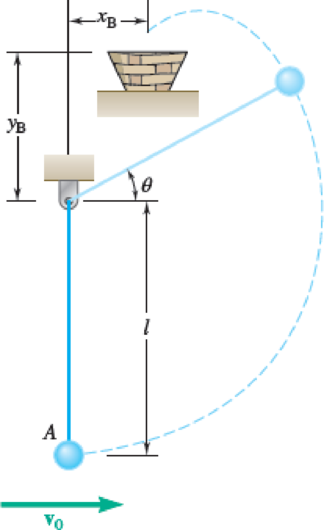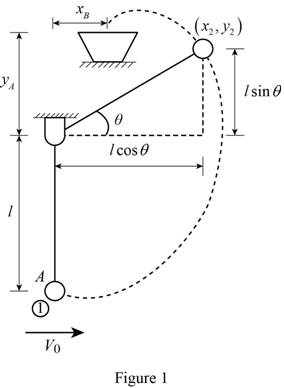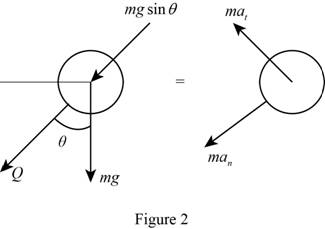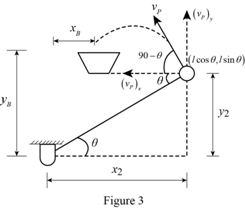
Concept explainers
The 2-lb ball at A is suspended by an inextensible cord and given an initial horizontal velocity of v0. If l = 2 ft, xB = 0.3 ft, and yB = 0.4 ft, determine the initial velocity v0 so that the ball will enter the basket. (Hint: Use a computer to solve the resulting set of equations.)
Fig. P13.201

Find the initial velocity
Answer to Problem 13.201RP
The initial velocity
Explanation of Solution
Given information:
The weight of the ball (m) is
The length of the cord (l) is
The horizontal distance between the basket and point of suspension of the ball
The vertical distance between basket and point of suspension of the ball
The acceleration due to gravity (g) is
Calculation:
Show the diagram of the suspended ball by an inextensible cord as in Figure (1).

Assume that position ‘1’ be at A and position ‘2’ be at the point described by the angle where the path of the ball changes from circular to parabolic.
The tension in the cord at position ‘2’, becomes slack
Refer Figure (1),
The expression for the x-coordinate of the ball at position ‘2’
The expression for the y-coordinate of the ball at position ‘2’
Show the free body diagram of the ball at position ‘2’ as in Figure (2).

The expression for the normal acceleration of the ball
Since, the cord becomes slack at position ‘2’, so the tension (Q) will be zero.
Calculate the velocity of the ball by applying Newton’s second law and resolve the forces acting on the ball at position ‘2’ using the relation:
Substitute
Substitute 0 for
The expression for the kinetic energy of the ball at position ‘1’
Calculate the potential energy of the ball at position ‘1’
Here, negative sign is used as the ball is located below the datum level and h is the vertical distance of the ball from the datum level.
Substitute
The expression for the kinetic energy of the ball at position ‘2’
The expression for the vertical distance of the ball by referring the Figure 1 as follows:
Calculate the potential energy of the ball at position ‘2’
Substitute
The expression for principle of conservation of energy at position ‘1’ and position ‘2’ for the ball, to calculate the angle swept by the ball
Substitute
Find the velocity at position 2:
Substitute
Show the parabolic motion of the ball after it reaches position ‘2’ as in Figure (3).

The expression for the velocity of the projectile ball after reaching the position ‘2’
Here,
The expression for the horizontal velocity component of the projectile ball along the negative X-axis as follows:
The expression for the horizontal distance between the basket and point of suspension of the ball
Here,
Substitute
Substitute
The expression for the vertical velocity component of the projectile ball along the negative X-axis as follows:
The expression for the vertical distance between the basket and point of suspension of the ball
Substitute
Substitute
Use trial and error method to calculate the value of
Case (1):
Try
Find the velocity at position 2:
Substitute
Find the time difference between basket and ball:
Substitute
Find the vertical distance between basket and ball:
Substitute
Case (2):
Try
Find the velocity at position 2:
Substitute
Find the time difference between basket and ball:
Substitute
Find the vertical distance between basket and ball:
Substitute
Case (3):
Try
Find the velocity at position 2:
Substitute
Find the time difference between basket and ball:
Substitute
Find the vertical distance between basket and ball:
Substitute
The expression for the data point as follows:
From above calculations, the following set of data points is obtained.
Calculate the general form of quadratic Equation.
Here, a, b, c are constants.
Substitute 0 for
Substitute
Substitute
Solve the equation (7) and equation (8).
Substitute
Substitute
Solve the above equation.
Calculate the angle
Substitute
Find the velocity at position 2:
Substitute
Find the initial velocity
Substitute
Therefore, the initial velocity
Want to see more full solutions like this?
Chapter 13 Solutions
Vector Mechanics for Engineers: Statics and Dynamics
- The two spheres shown collide. the weight of the first sphere (W1) is 40 N while that of the second is (W2) is 30N. assuming that the second sphere's velocity (v2) is 14 m/s and the first sphere's velocity (v1) is 16 m/s along the their respective angles. theta 1(θ1)=30 degrees and theta 2(θ2)=60 degrees. Assume velocities along y will be equal before and after impact. The coefficient of restitution is 0.57. A.) Determine the velocity of the 30N sphere after impact (m/s) B.) Determine the Velocity of the 40N sphere after impact (m/s) C.) Determine the angle of the velocity after impact of the 40N sphere with the horizontal (degrees) D.) Determine the angle of the velocity after impact for the 30N sphere with the vertical (degrees)arrow_forwardCar A has a weight of 4500 Ib and is traveling to the right at 3 ft/s. Meanwhile, a 3000-lb car B is traveling at 6 ft/s to the left. If the cars crash head-on and become entangled, determine their common velocity in ft/s just after the collision. Assume that the brakes are not applied during a collision.arrow_forwardA particle of mass m is projected from point A with an initial velocity v0 perpendicular to OA and moves under a central force F along an elliptic path defined by the equation r=r0 /(2 - cos 0) Using Eq. (12.35), show that F is inversely proportional to the square of the distance r from the particle to the center of force 0.arrow_forward
- A 3 kg slider is released from rest at point A and slides with negligible friction' in a vertical plane along the circular rod. The attached spring has a stiffness of 350 N/m and has an unstretched length of 0.75 m. a) Which of the following gives the gravitational potential energy if the slider passes position B. b) Which of the following gives the elastic potential energy if the slider passes position B. c) Which of the following gives the velocity of slider as it passes position Barrow_forwardDirect central impact occurs between a 100lbs body moving to the right at 5 ft per second and a body of weight W moving to the left at 3 ft per sec. The coefficient of restitution e = 0.5. After impact the 100lb body rebounds to the left at 2ft/s. Determine the weight W of the other body. (lbs)arrow_forwardThe two disks A and B have a mass of 4 kg and 6 kg , respectively. They collide with the initial velocities shown. The coefficient of restitution is e = 0.65. Suppose that (vA)1 = 6 m/s , (vB)1 = 7 m/s Determine the magnitude of the velocity of A just after impact. Determine the angle between the x axis and the velocity of A just after impact, measured clockwise from the negative x axis. Determine the magnitude of the velocity of B just after impact. Determine the angle between the x axis and the velocity of B just after impact, measured clockwise from the positive x axis.arrow_forward
- Situation 01. A 4kg ball and 3kg ball move on a smooth plane along a straight path with speeds equivalent to 6m/s going to the right and 8 m/s going to the left, respectively a. Determine the speed of the 3kg ball after impact if the impact is elastic. b. Determine the speed of the 3kg ball after impact if the coefficient of restitution is 0.50. complete solution of impulse and momentumarrow_forwardWhen the rope is at an angle of a= 30°, the 1-kg sphere A has a speed v0 = 0.6 m/s. The coefficient of restitution between A and the 2-kg wedge B is 0.8 and the length of rope I = 0.9 m. The spring constant has a value of 1500 N/m and 0= 20°. Determine (a) the velocities of A and B immediately after the impact, (b) the maximum deflection of the spring, assuming A does not strike B again before this point.arrow_forwardA 30,000 kg spacecraft is approaching the moon on a hyperbolic trajectory at an altitude of 1,000 km and a speed of 10 km/s. The spacecraft must be lowered into a circular parking orbit with altitude of 100 km. After three orbits at 100 km for system checks, the lander is deployed and conducts a maneuver to land on the surface of the moon at a position 180° from the impulse point. Determine the total required Δ? to conduct the transfer into the circular orbit, in km/s Determine the required propellant mass for that maneuver, in kg Determine the required Δ? to transfer to the landing trajectory Determine the total time required from the start of the initial transfer orbit until landing, in harrow_forward
- Blocks A and B weigh 25 lb and 10 lb, respectively, and they are both at a height 6 ft above the ground when the system is released from rest. Just before hitting the ground, block A is moving at a speed of 9 ft/s. Determine (a) the amount of energy dissipated in friction by the pulley, (b) the tension in each portion of the cord during the motion.arrow_forwardA small package of weight W is projected into a vertical return loop at A with a velocity v0 . The package travels without friction along a circle of radius r and is deposited on a horizontal surface at C. For each of the two loops shown, determine (a) the smallest velocity v0 for which the package will reach the horizontal surface at C, (b) the corresponding force exerted by the loop on the package as it passes point B.arrow_forwardThe 12-lb box slides on the surface for which μk = 0.3. The box has a velocity v = 15 ft/s when it is 2 ft from the plate. a) If the box strikes the smooth plate, which has a weight of 22 lb and is held in position by an unstretched spring of stiffness k = 440 lb/ft, determine the maximum compression imparted to the spring. Take e = 0.8 between the box and the plate. Assume that the plate slides smoothly. x = ?arrow_forward
 Elements Of ElectromagneticsMechanical EngineeringISBN:9780190698614Author:Sadiku, Matthew N. O.Publisher:Oxford University Press
Elements Of ElectromagneticsMechanical EngineeringISBN:9780190698614Author:Sadiku, Matthew N. O.Publisher:Oxford University Press Mechanics of Materials (10th Edition)Mechanical EngineeringISBN:9780134319650Author:Russell C. HibbelerPublisher:PEARSON
Mechanics of Materials (10th Edition)Mechanical EngineeringISBN:9780134319650Author:Russell C. HibbelerPublisher:PEARSON Thermodynamics: An Engineering ApproachMechanical EngineeringISBN:9781259822674Author:Yunus A. Cengel Dr., Michael A. BolesPublisher:McGraw-Hill Education
Thermodynamics: An Engineering ApproachMechanical EngineeringISBN:9781259822674Author:Yunus A. Cengel Dr., Michael A. BolesPublisher:McGraw-Hill Education Control Systems EngineeringMechanical EngineeringISBN:9781118170519Author:Norman S. NisePublisher:WILEY
Control Systems EngineeringMechanical EngineeringISBN:9781118170519Author:Norman S. NisePublisher:WILEY Mechanics of Materials (MindTap Course List)Mechanical EngineeringISBN:9781337093347Author:Barry J. Goodno, James M. GerePublisher:Cengage Learning
Mechanics of Materials (MindTap Course List)Mechanical EngineeringISBN:9781337093347Author:Barry J. Goodno, James M. GerePublisher:Cengage Learning Engineering Mechanics: StaticsMechanical EngineeringISBN:9781118807330Author:James L. Meriam, L. G. Kraige, J. N. BoltonPublisher:WILEY
Engineering Mechanics: StaticsMechanical EngineeringISBN:9781118807330Author:James L. Meriam, L. G. Kraige, J. N. BoltonPublisher:WILEY





